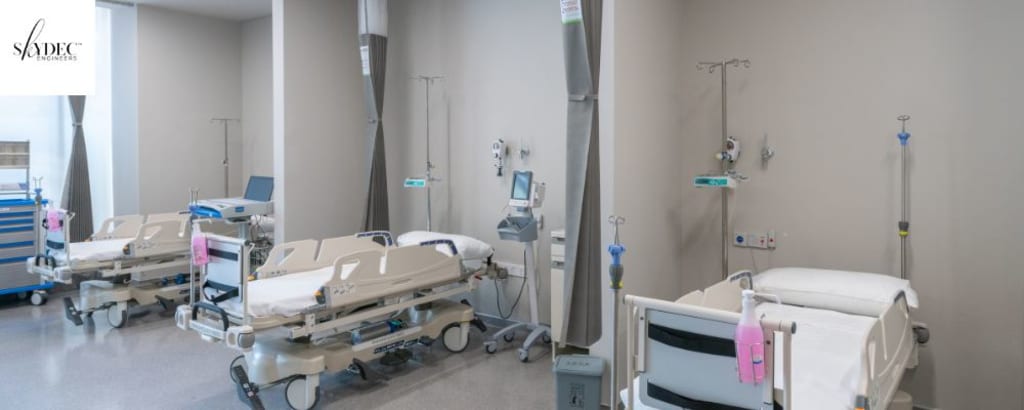What are Common Mistakes to Avoid in ICU Interior Design?
ICU Interior Design

Introduction
Intensive care units (ICUs) are critical care environments where patients receive specialized medical attention. The design of these spaces plays a crucial role in patient recovery, staff efficiency, and overall healthcare outcomes. However, there are certain mistakes that can compromise the functionality and effectiveness of ICU interiors Design.
To ensure optimal patient care and a supportive environment for both patients and staff, it is essential to avoid these common design pitfalls:
1. Insufficient Natural Light:
Natural light has a profound impact on patient well-being and recovery. Inadequate natural light can lead to depression, anxiety, and impaired sleep patterns. In ICU design, it is crucial to incorporate ample windows or skylights to provide patients with access to the outdoors. Natural light can also reduce glare and create a more calming atmosphere.
2. Poor Ventilation and Air Quality:
ICUs generate a significant amount of airborne contaminants, including bacteria, viruses, and medical gases. Proper ventilation is essential to maintain good air quality and prevent the spread of infections. Avoid designs that restrict airflow or create dead air spaces. Adequate mechanical ventilation and air filtration systems are crucial to ensure a clean and healthy environment for patients and staff.
3. Cramped and Cluttered Spaces:
ICUs often require a wide range of equipment and medical devices. However, overcrowding and clutter can compromise patient safety and staff efficiency. Avoid designs that create unnecessary obstructions or make it difficult for staff to move around freely. Proper planning and organization are essential to create a spacious and functional ICU environment.
4. Lack of Privacy and Quiet Spaces:
Patients in ICUs need privacy and quiet spaces to rest and recover. Avoid designs that expose patients to excessive noise or disturbances. Create designated zones within the ICU for private consultations, family visits, and moments of respite. Provide sound-absorbing materials and noise-dampening measures to minimize distractions and promote tranquility.
5. Neglecting Family Involvement:
Families play a vital role in patient care and recovery. ICU designs should accommodate family members and provide them with comfortable spaces where they can stay close to their loved ones. Include designated waiting areas, family lounges, and sleeping arrangements to support and comfort families during this stressful time.
6. Ignoring Patient Comfort and Dignity:
Patients in ICUs are often experiencing physical and emotional distress. The design should prioritize patient comfort and dignity. Provide adjustable beds, comfortable seating, and accessible controls to empower patients and give them a sense of control over their environment. Respect patient privacy with curtains or screens around beds and avoid unnecessary exposure or humiliation.
7. Overreliance on Technology:
While technology plays a crucial role in ICU care, it should not overshadow the human element. Avoid designs that rely solely on automated systems and neglect the importance of personal interaction. Ensure that staff have adequate workspace and resources to provide individualized and compassionate care to patients.
8. Lack of Flexibility and Adaptability:
ICUs must be able to adapt to changing patient needs and technological advancements. Avoid rigid designs that cannot accommodate future changes or modifications. Plan for flexibility in terms of space utilization, equipment placement, and technological integration to ensure the ICU remains effective and up-to-date over time.
9. Ignoring Infection Control Measures:
Infection control is paramount in ICU design. Avoid surfaces that are difficult to clean or disinfect. Choose materials that are non-porous and resistant to microbial growth. Implement proper hand hygiene protocols and ensure that all surfaces and equipment are regularly disinfected to prevent the spread of infections.
10. Neglecting Staff Well-being:
Staff well-being is essential for optimal patient care. ICU design should consider the needs of healthcare providers. Provide comfortable workspaces with ergonomic seating, adequate lighting, and access to necessary amenities. Address staff safety concerns, such as proper ventilation, noise reduction, and protection from hazardous substances.
Conclusion:
By avoiding these common mistakes, ICU interior design can create a space that promotes patient recovery, supports staff efficiency, and fosters a sense of well-being for all. Our expertise in healthcare interior design extends beyond the ICU to encompass a range of medical facilities, including Medical Shop interior design,Dental Clinic interior design, and small pathology lab interior design. A well-designed environment not only improves patient outcomes and enhances staff morale but also contributes to the overall success of the healthcare facility.
For expert assistance in ICU interior design, contact Skydec Engineers. Our team of experienced professionals specializes in creating functional, patient-centered ICU environments that meet the highest standards of infection control and patient care. Call us at 9818153338 to schedule a consultation and take the first step towards optimizing your ICU design.
About the Creator
Enjoyed the story? Support the Creator.
Subscribe for free to receive all their stories in your feed. You could also pledge your support or give them a one-off tip, letting them know you appreciate their work.





Comments
There are no comments for this story
Be the first to respond and start the conversation.